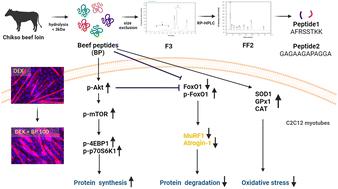当前位置:
X-MOL 学术
›
Food Funct.
›
论文详情
Our official English website, www.x-mol.net, welcomes your feedback! (Note: you will need to create a separate account there.)
Beef peptides mitigate skeletal muscle atrophy in C2C12 myotubes through protein degradation, protein synthesis, and the oxidative stress pathway
Food & Function ( IF 6.1 ) Pub Date : 2024-03-25 , DOI: 10.1039/d3fo03911k Hyeonjin Hur 1 , Hye-Jin Kim 1 , Dongheon Lee 1 , Cheorun Jo 1, 2, 3
Food & Function ( IF 6.1 ) Pub Date : 2024-03-25 , DOI: 10.1039/d3fo03911k Hyeonjin Hur 1 , Hye-Jin Kim 1 , Dongheon Lee 1 , Cheorun Jo 1, 2, 3
Affiliation

|
This study aimed to investigate the potential of beef peptides (BPs) in mitigating muscle atrophy induced by dexamethasone (DEX) with underlying three mechanisms in vitro (protein degradation, protein synthesis, and the oxidative stress pathway). Finally, the anti-atrophic effect of BPs was enhanced through purification and isolation. BPs were generated using beef loin hydrolyzed with alcalase/ProteAX/trypsin, each at a concentration of 0.67%, followed by ultrafiltration through a 3 kDa cut-off. BPs (10–100 μg mL−1) dose-dependently counteracted the DEX-induced reductions in myotube diameters, differentiation, fusion, and maturation indices (p < 0.05). Additionally, BPs significantly reduced FoxO1 protein dephosphorylation, thereby suppressing muscle-specific E3 ubiquitin ligases such as muscle RING-finger containing protein-1 and muscle atrophy F-box protein in C2C12 myotubes at concentrations exceeding 25 μg mL−1 (p < 0.05). BPs also enhanced the phosphorylation of protein synthesis markers, including mTOR, 4E-BP1, and p70S6K1, in a dose-dependent manner (p < 0.05) and increased the mRNA expression of antioxidant enzymes. Fractionated peptides derived from BPs, through size exclusion and polarity-based fractionation, also demonstrated enhanced anti-atrophic effects compared to BPs. These peptides downregulated the mRNA expression of primary muscle atrophy markers while upregulated that of antioxidant enzymes. Specifically, peptides GAGAAGAPAGGA (MW 924.5) and AFRSSTKK (MW 826.4) were identified from fractionated peptides of BPs. These findings suggest that BPs, specifically the peptide fractions GAGAAGAPAGGA and AFRSSTKK, could be a potential strategy to mitigate glucocorticoid-induced skeletal muscle atrophy by reducing the E3 ubiquitin ligase activity.
中文翻译:

牛肉肽通过蛋白质降解、蛋白质合成和氧化应激途径减轻 C2C12 肌管中的骨骼肌萎缩
本研究旨在探讨牛肉肽(BP)通过体外三种潜在机制(蛋白质降解、蛋白质合成和氧化应激途径)减轻地塞米松(DEX)引起的肌肉萎缩的潜力。最后,通过纯化和分离增强了BPs的抗萎缩作用。 BP 使用 Alcalase/ProteAX/胰蛋白酶水解牛腰肉生成,每种浓度均为 0.67%,然后通过 3 kDa 截留值进行超滤。 BP(10–100 μg mL -1)剂量依赖性地抵消了 DEX 诱导的肌管直径、分化、融合和成熟指数的减少(p < 0.05)。此外,BP 显着降低 FoxO1 蛋白去磷酸化,从而抑制肌肉特异性 E3 泛素连接酶,例如浓度超过 25 μg mL -1的 C2C12 肌管中含有 Protein-1 的肌肉 RING-finger 和肌肉萎缩 F-box 蛋白( p < 0.05) 。 BP 还以剂量依赖性方式增强蛋白质合成标记物的磷酸化,包括 mTOR、4E-BP1 和 p70S6K1 ( p < 0.05),并增加抗氧化酶的 mRNA 表达。与 BP 相比,通过尺寸排阻和基于极性的分级分离,从 BP 衍生的分级肽也表现出增强的抗萎缩作用。这些肽下调原发性肌肉萎缩标记物的 mRNA 表达,同时上调抗氧化酶的 mRNA 表达。具体而言,从 BP 的分级肽中鉴定出肽 GAGAAGAPAGGA (MW 924.5) 和 AFRSSTKK (MW 826.4)。这些发现表明,BP,特别是肽片段 GAGAAGAPAGGA 和 AFRSSTKK,可能是通过降低 E3 泛素连接酶活性来减轻糖皮质激素诱导的骨骼肌萎缩的潜在策略。
更新日期:2024-03-25
中文翻译:

牛肉肽通过蛋白质降解、蛋白质合成和氧化应激途径减轻 C2C12 肌管中的骨骼肌萎缩
本研究旨在探讨牛肉肽(BP)通过体外三种潜在机制(蛋白质降解、蛋白质合成和氧化应激途径)减轻地塞米松(DEX)引起的肌肉萎缩的潜力。最后,通过纯化和分离增强了BPs的抗萎缩作用。 BP 使用 Alcalase/ProteAX/胰蛋白酶水解牛腰肉生成,每种浓度均为 0.67%,然后通过 3 kDa 截留值进行超滤。 BP(10–100 μg mL -1)剂量依赖性地抵消了 DEX 诱导的肌管直径、分化、融合和成熟指数的减少(p < 0.05)。此外,BP 显着降低 FoxO1 蛋白去磷酸化,从而抑制肌肉特异性 E3 泛素连接酶,例如浓度超过 25 μg mL -1的 C2C12 肌管中含有 Protein-1 的肌肉 RING-finger 和肌肉萎缩 F-box 蛋白( p < 0.05) 。 BP 还以剂量依赖性方式增强蛋白质合成标记物的磷酸化,包括 mTOR、4E-BP1 和 p70S6K1 ( p < 0.05),并增加抗氧化酶的 mRNA 表达。与 BP 相比,通过尺寸排阻和基于极性的分级分离,从 BP 衍生的分级肽也表现出增强的抗萎缩作用。这些肽下调原发性肌肉萎缩标记物的 mRNA 表达,同时上调抗氧化酶的 mRNA 表达。具体而言,从 BP 的分级肽中鉴定出肽 GAGAAGAPAGGA (MW 924.5) 和 AFRSSTKK (MW 826.4)。这些发现表明,BP,特别是肽片段 GAGAAGAPAGGA 和 AFRSSTKK,可能是通过降低 E3 泛素连接酶活性来减轻糖皮质激素诱导的骨骼肌萎缩的潜在策略。



























 京公网安备 11010802027423号
京公网安备 11010802027423号